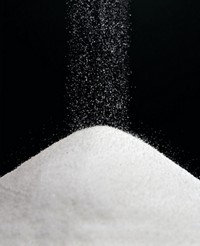Advertisement
Grab your lab coat. Let's get started
Welcome!
Welcome!
Create an account below to get 6 C&EN articles per month, receive newsletters and more - all free.
It seems this is your first time logging in online. Please enter the following information to continue.
As an ACS member you automatically get access to this site. All we need is few more details to create your reading experience.
Not you? Sign in with a different account.
Not you? Sign in with a different account.
ERROR 1
ERROR 1
ERROR 2
ERROR 2
ERROR 2
ERROR 2
ERROR 2
Password and Confirm password must match.
If you have an ACS member number, please enter it here so we can link this account to your membership. (optional)
ERROR 2
ACS values your privacy. By submitting your information, you are gaining access to C&EN and subscribing to our weekly newsletter. We use the information you provide to make your reading experience better, and we will never sell your data to third party members.
Environment
Newscripts
Sugar High ... Jinks
by Alexander H. Tullo
July 6, 2009
| A version of this story appeared in
Volume 87, Issue 27

Recently, I wrote a C&EN News of the Week article about Coca-Cola's plans to substitute petrochemically derived ethylene glycol with glycol made from sugar and molasses to make polyethylene terephthalate beverage bottles (C&EN, May 25, page 9). Researching the story made me wish that Coca-Cola could put sugar to better use, namely, making soda.
For soda lovers like me, the past 30 years have been unkind in one respect: High-fructose corn syrup (HFCS) has replaced sugar in nearly all beverages in the U.S.
The TWO SWEETENERS are chemically different. Common sugar is sucrose, a disaccharide of glucose and fructose. High-fructose corn syrup is a mixture made of glucose and fructose—55% fructose in HFCS-55, the type of syrup used in beverages. To make HFCS, corn refiners use the enzyme glucoamylase to break cornstarch down into glucose and then use the enzyme glucose isomerase to convert some of the glucose into fructose.
HFCS was introduced in the late 1960s, and by the 1980s, it had conquered the U.S. beverage industry. In 1982, the U.S. government imposed quotas that limit sugar imports. Since then, U.S. sugar prices have generally been much higher than global sugar prices. And HFCS-55 has been cheaper on a comparable basis—it contains about 23% water—than sugar in the U.S. Recently, however, the margin between the two has narrowed.
Because of the price differential, and because it's easier to handle a liquid than a solid on an industrial scale, use of HFCS in soft drinks and processed food skyrocketed in the 1980s. According to the U.S. Department of Agriculture, per capita annual consumption of sugar was 84 lb in 1980. By 1990, it was 64 lb. During the same period, per capita annual consumption of HFCS increased from 19 lb to 50 lb.
Today, finding soda made with sugar in the U.S. is as difficult as it was to procure Levi's dungarees in the Soviet Union. That's an exaggeration, but one does have to know where to look. One source is Coca-Cola made in Mexico, typically available for sale at any grocer that displays a Mexican flag prominently in the window. Another source, kosher Coca-Cola, can be found in many supermarkets around Passover because corn is shunned during that holiday.
There are other sugar-based sodas as well. One Dr Pepper bottler in Dublin, Texas, still uses sugar. People can buy "Dublin Dr Pepper" over the Internet or stumble across it at, say, a truck stop along a Texas highway. There are also gourmet brands such as Jones Soda or Royal Crown Draft that use pure cane sugar.
This past spring, Pepsi made life easier for soda aficionados. It released Pepsi and Mountain Dew Throwback brands made with real sugar, which was available from April to June.
One wonders about Pepsi's motives. Some nutritionists say HFCS is a worse contributor to obesity than sugar is, so there could be some marketing benefit.
Whatever the company's motivation, its efforts offered a rare opportunity to settle the matter of which tastes better, soda made with sugar or with HFCS.
I arranged a Pepsi Challenge—normal Pepsi versus Pepsi Throwback—at C&EN's Northeast News Bureau. Admittedly, I had a very small statistical sample for the blind taste test: three subjects, including my biased self. All agreed that regular Pepsi made an immediate impact on the tip of the tongue, whereas the subtler effects of Pepsi Throwback worked toward the back of the mouth. One subject liked regular Pepsi better, noting that Throwback "tastes like diet." The two others, including me, preferred sugar.
Alexander H. Tullo wrote this week's column. Please send comments and suggestions to newscripts@acs.org.



Join the conversation
Contact the reporter
Submit a Letter to the Editor for publication
Engage with us on Twitter